s = 1 + 2 + 4 + 8 + 16 + ... = 1 + 2(1 + 2 + 4 + 8 + ...) = 1 + 2s, so -1 = 1 + 2 + 4 + 8 + 16 + ...
(Regular summation gives a sum of infinity, but the idea above does make a certain sense.)
(Thanks, Murtadha.)
s = 1 + 2 + 4 + 8 + 16 + ... = 1 + 2(1 + 2 + 4 + 8 + ...) = 1 + 2s, so -1 = 1 + 2 + 4 + 8 + 16 + ...
(Regular summation gives a sum of infinity, but the idea above does make a certain sense.)
(Thanks, Murtadha.)
One other oddity concerning π: If you add up the first three sextads in the decimal expansion, you get 1588419:
141592 + 653589 + 793238 = 1588419
That’s a little prophecy: If you now skip ahead 15 places you arrive at the string 88419:
3.1415926535897932384626433832795028841971693 …
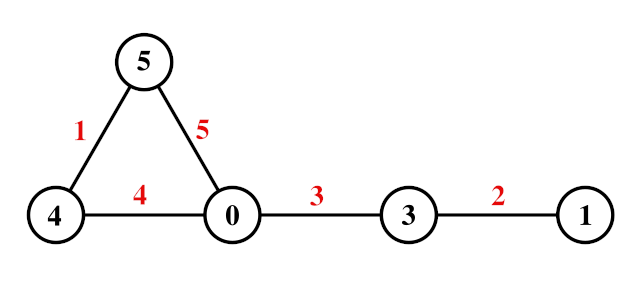
This graph has 5 edges, and we’ve managed to label its vertices in a remarkable way: Each vertex bears some integer from 0 to 5, no two receive the same integer, and each edge is now uniquely identified by the absolute difference between its endpoints, such that this magnitude lies between 1 and 5 inclusive. Such a labeling is called graceful.
In 2008 Donald E. Knuth made a graph representing the contiguous 48 states and the District of Columbia in which each pair of states are connected if they’re joined by at least one drivable road. It turns out that this graph can be labeled gracefully.
And, amazingly, in 2020 T. Rokicki discovered that if you undertake an imaginary journey on Knuth’s map, starting in California and going up the Pacific coast and then along the Canadian border, you’ll visit successive vertices labeled 31, 41, 59, 26, 53, 58, 97, 93, 23, 84, 62, 64, 33, 83, and 27. These are the first 30 decimal digits of π!
Knuth called this a “graceful miracle.”
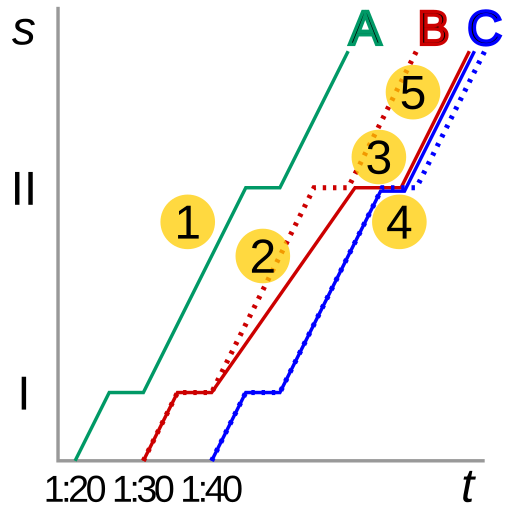
When two or more buses are scheduled at regular intervals on the same route, planners may expect that each will make the same progress, pausing at each stop for the same interval (1). But if Bus B is delayed by traffic congestion (2), it incurs a penalty: Because it arrives late to the next stop, it will pick up some passengers who’d planned to take Bus C (3). Accommodating these passengers delays Bus B even longer, putting it even further behind schedule. Meanwhile, Bus C begins to make unusually good progress (4), as it now arrives at each stop to find a smaller crowd than expected.
As the workload piles up on the foremost bus and the one behind it catches up, eventually the result (5) is that the two buses run in a platoon, arriving together at each stop. Sometimes Bus C even overtakes Bus B.
What to do? Planners can set minimum and maximum amounts of time to be spent at each stop, and buses might even be told to skip certain stops during crowded runs. Passengers might be encouraged to wait for a following bus, with the inducement that it’s less crowded. Northern Arizona University improved its service by abandoning the idea of a schedule altogether and delaying buses at certain stops in order to maintain even spacing. One thing that doesn’t work: adding vehicles to the route — which might, at first blush, have seemed the obvious solution.
(Via Robert A. Carman, “Mathematical Misteaks,” Mathematics Teacher 64:2 [February 1971], 109-115.)
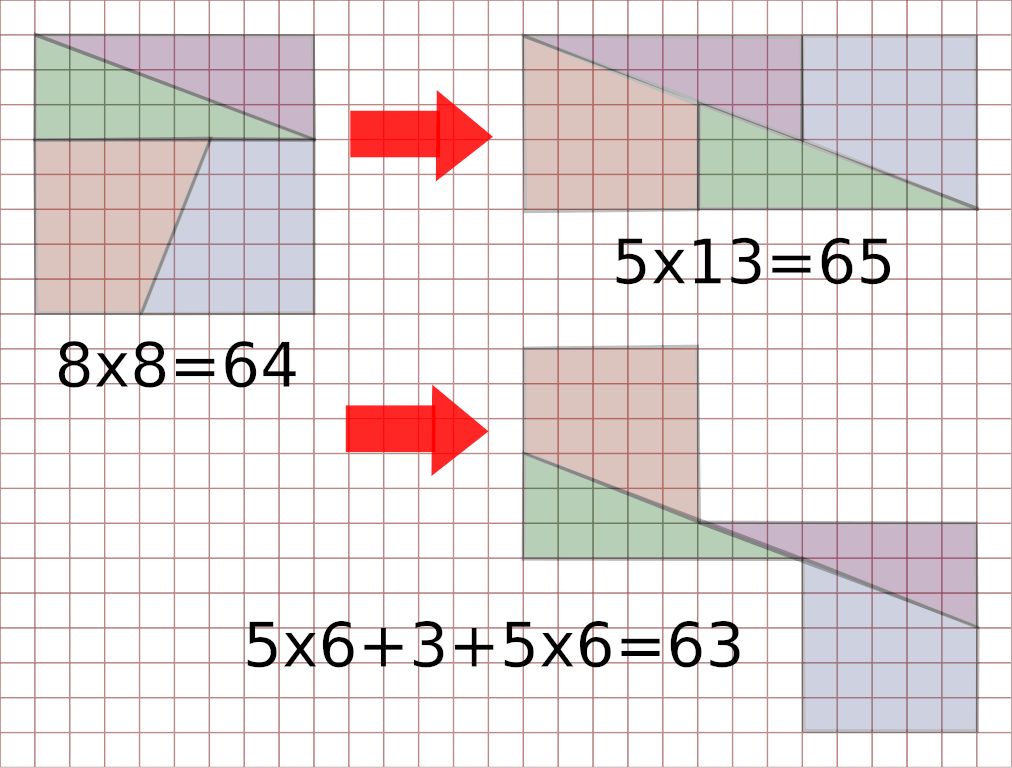
This worrying result was first published by German mathematician Oskar Schlömilch in 1868. (The discrepancy is explained by minute gaps in the diagonals, as explained here.)
Charles Dodgson (Lewis Carroll) seems to have been taken with the paradox — his papers show that between 1890 and 1893 he was working to determine all the squares that might similarly be converted into rectangles with a “gain” of one unit of area, apparently unaware that V. Schlegel had carried out the same task much earlier.
(Warren Weaver, “Lewis Carroll and a Geometrical Paradox,” American Mathematical Monthly 45:4 [April 1938], 234-236.)
“A Time-Series Analysis of My Girlfriend’s Mood Swings”
“Behavioral Conditioning Methods to Stop My Boyfriend From Playing The Witcher 3”
“Sub-Nyquist Sampling While Listening to My Girlfriend”
“Who Should Do the Dishes? A Transportation Problem Solution”
“Freudian Psychoanalysis of My Boyfriend’s Gun Collection”
“The Future of Romance: Novel Techniques for Replacing Your Boyfriend With Generative AI”
“Winning Tiffany Back: How to Defeat an AI Boyfriend”
Via r/ImmaterialScience.
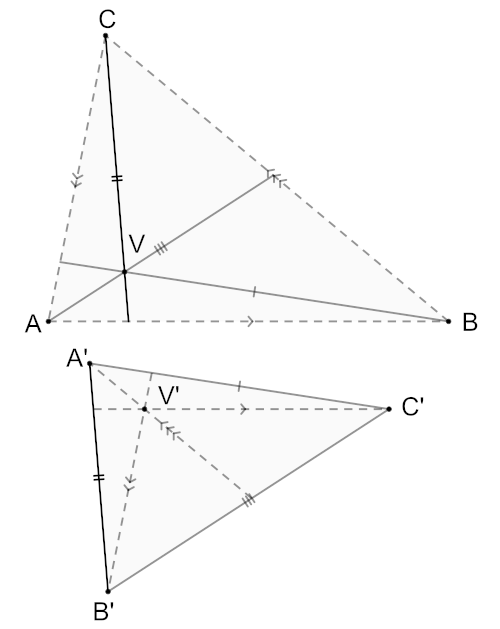
Draw a triangle ABC and pick a point V that’s not on one of its sides. Draw a segment from each of the triangle’s vertices through V. Now draw a new triangle whose sides are parallel to these three segments. Segments drawn from each of this new triangle’s vertices and parallel to the first triangle’s sides, as shown, will meet in a common point.
Proven by James Clerk Maxwell!
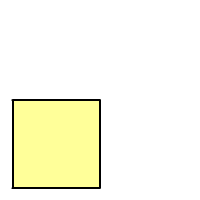
Each side of the yellow square is 2 feet long. In the Meno, Socrates asks a slave boy how long would be the side of a square that had twice the yellow square’s area. The boy guesses first 4 feet, then 3, and finds himself at a loss.
Socrates builds a square four times the size of the yellow one, then divides each of its constituent squares in half with a diagonal. The area of the blue square is thus twice that of the yellow one, and its side has the length we’d sought.
“Some things I have said of which I am not altogether confident,” Socrates tells Meno. “But that we shall be better and braver and less helpless if we think that we ought to enquire, than we should have been if we indulged in the idle fancy that there was no knowing and no use in seeking to know what we do not know; that is a theme upon which I am ready to fight, in word and deed, to the utmost of my power.”
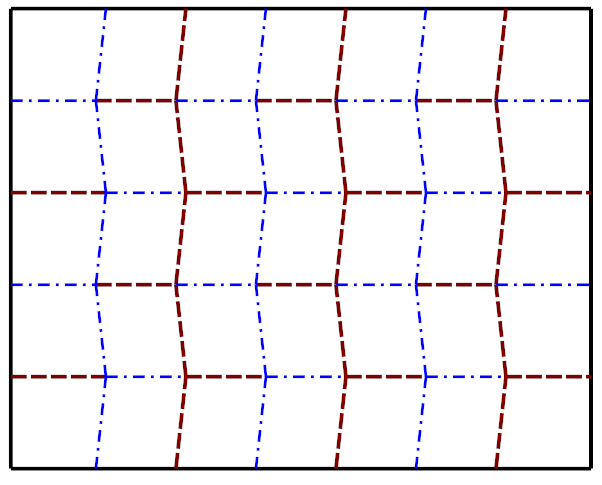
In 1980, Japanese astrophysicist Kōryō Miura worked out a pattern of parallelograms that permit a map to be folded much more compactly than conventional right-angle creases. So efficient is the pattern that a map can be opened or refolded with a single motion by pulling on opposite ends, rather like an accordion. Today it’s used to fold surgical devices, furniture, and solar panel arrays on spacecraft.